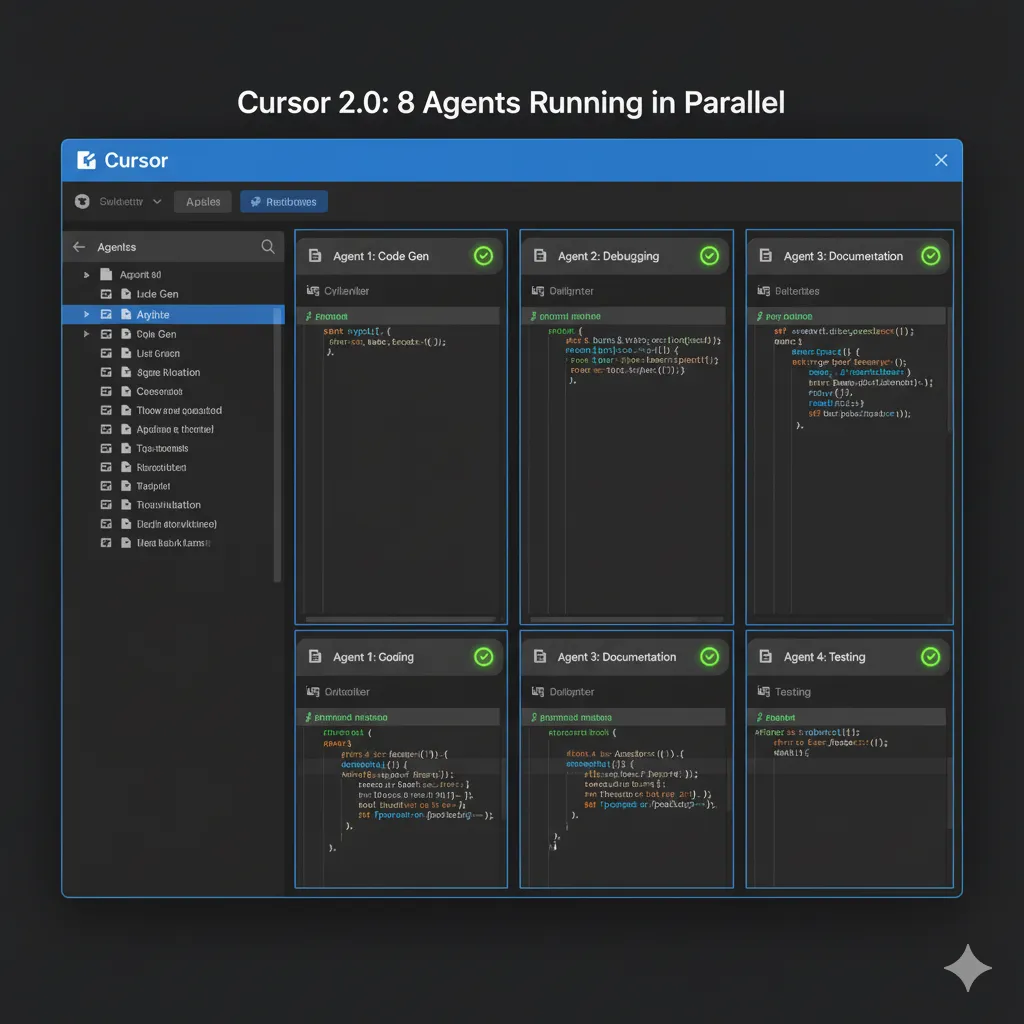🆕 Latest Update (October 29, 2025): Cursor 2.0 launched with Composer (proprietary coding model), multi-agent interface supporting 8 parallel agents, native browser testing, sandboxed terminals, and voice input. Valuation now $9.9B with $500M+ ARR.
The Bottom Line
If you remember nothing else: Cursor 2.0 is basically VS Code rebuilt from scratch to put AI agents in charge. It launched October 29, 2025 with its own coding model (Composer) that completes tasks in 62 seconds average vs GitHub Copilot’s 89 seconds—but with lower accuracy (51.7% vs 56.5% success rate). Best for experienced developers working on complex, multi-file projects who can afford $20-$200/month. Skip it if you’re learning to code, prefer GUI simplicity, or work primarily on small scripts.
The catch: Cursor changed its pricing model in June 2025 from predictable request limits to confusing credit-based usage, causing major community backlash. They apologized publicly but trust was damaged. Plus, it struggles with large monorepos (10,000+ files) and you’re essentially beta-testing features that break frequently.
Real benchmarks from 500 coding tasks: Cursor finished faster but solved fewer problems correctly. Translation: speed doesn’t equal quality. You’ll be reviewing AI code constantly, not relaxing while it works.
Best for: Professional developers spending 20+ hours/week coding who value speed over perfection. Worst for: Beginners, budget-conscious hobbyists, or anyone expecting “set it and forget it” automation.
Alternatives worth considering: Claude Code ($20-200/mo, better context understanding), GitHub Copilot ($10/mo, more reliable for simple tasks), or Aider (free, requires API key management). Check our Claude Code Review 2025: Is It Worth $20-$200/Month? for details.
The pricing controversy you need to know: Cursor quietly switched from “$20 for 500 requests” to “$20 credit pool that depletes based on which AI model you use.” Some developers hit $40+ monthly bills unexpectedly. Check the latest AI news for ongoing pricing drama.
Click any section to jump directly to it
- 🎯 The Bottom Line
- 🔥 What Just Happened: Cursor 2.0 & Composer
- 🤖 What Cursor Actually Does
- ⚡ Getting Started: First 10 Minutes
- 💰 Pricing Breakdown: What You’ll Actually Pay
- 🔑 Features That Actually Matter
- 📊 Real Test Results: Cursor vs Copilot
- ⚖️ Head-to-Head: 5 Major Competitors
- 🎯 Best For, Worst For
- 💬 Community Verdict: The Pricing Betrayal
- 🔮 The Road Ahead
- ❓ FAQs: Your Questions Answered
- ✅ The Final Verdict
🔥 What Just Happened: Cursor 2.0 & Composer Explained
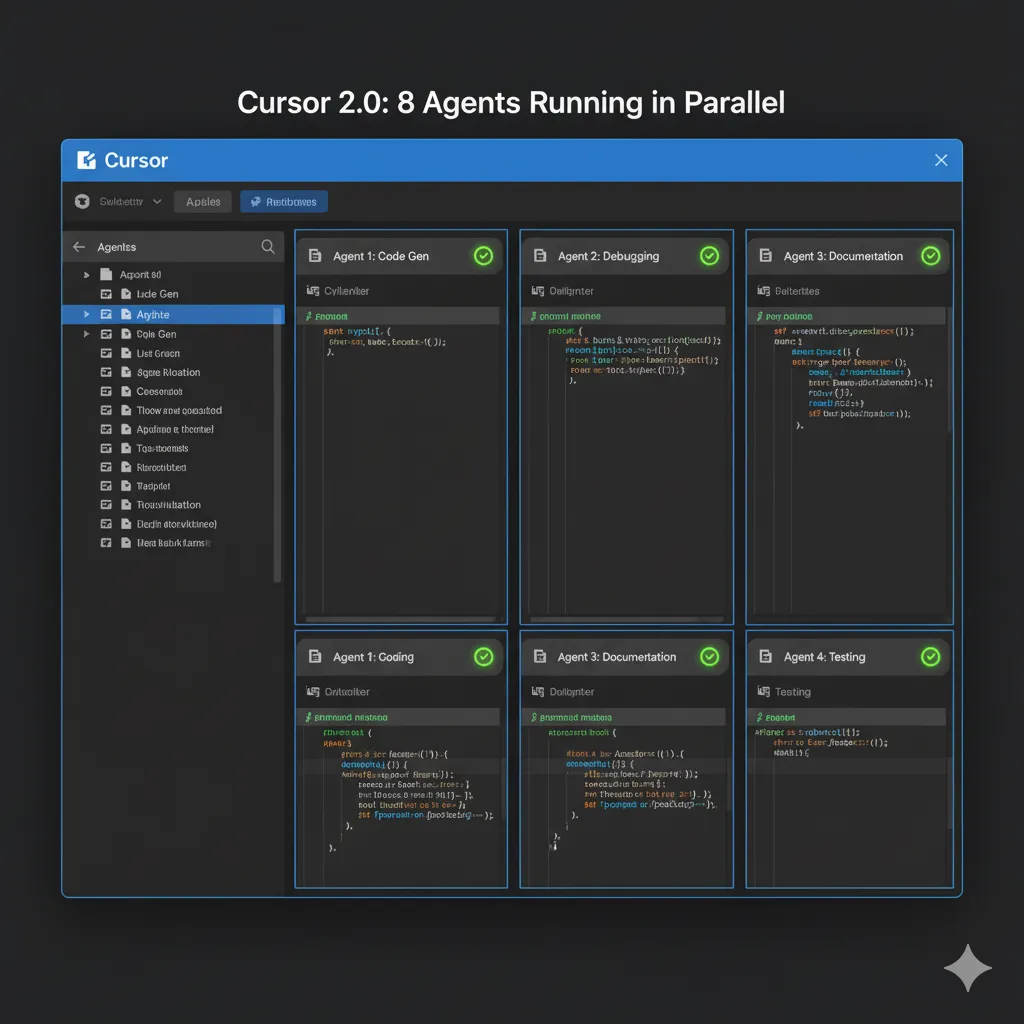
On October 29, 2025, Cursor dropped the biggest update in AI coding history. Not just new features—a complete redesign of how developers interact with AI.
The Major Changes
Composer: Their First Proprietary Model
Cursor built their own coding AI instead of just wrapping Claude or GPT. Why? Speed. Composer completes most coding tasks in under 30 seconds according to their benchmarks. That’s roughly 4x faster than comparable models.
How they built it: Mixture-of-Experts architecture, reinforcement learning training, custom MXFP8 quantization kernels. Translation: fancy tech that makes it fast but occasionally unreliable.
Multi-Agent Interface: Run 8 Coders Simultaneously
You can now spawn up to eight AI agents, each working in isolated workspaces. Think of it like managing a team of junior developers who never sleep but also never learn from mistakes.
How it works: Git worktrees keep each agent’s changes separate. You can test multiple approaches to the same problem in parallel, then pick the winner.
Reality check from developers: “Running multiple agents is like having 8 eager interns who all need constant supervision. Useful but exhausting.”
Native Browser Tool: Agents Test Their Own Work
Cursor agents can now open a browser, click buttons, and verify their code works. No more manually checking if that form actually submits.
The limitation: Only works for web UI testing. If you’re building CLI tools or backend services, you’re still testing manually.
The Valuation Nobody Saw Coming
Cursor’s parent company Anysphere raised $900 million at a $9.9 billion valuation. That’s unicorn territory. For context: they’re now valued higher than Stripe was at Series C.
The numbers backing this up: Over $500 million in annual recurring revenue, used by more than half of the Fortune 500 companies, scaled from $100M ARR to $500M+ in under a year.
One tech analyst noted: “This isn’t just another coding assistant. Cursor’s trajectory suggests they’re building the default development environment for the AI era.”
🔍 REALITY CHECK
Marketing Claims: “Revolutionary multi-agent coding that writes production-ready code while you focus on architecture”
Actual Experience: Cursor 2.0 writes initial implementations fast, but you’ll spend 30-50% of your time reviewing and fixing agent output. Independent benchmarks show 51.7% task success rate—meaning nearly half the attempts need human intervention.
Verdict: Genuinely innovative, but you’re still doing most of the thinking. The agents handle grunt work, not architectural decisions.
🤖 What Cursor Actually Does (Not The Marketing Hype)
Cursor is an AI-powered code editor built as a fork of VS Code. If you’ve used VS Code, you’ll feel at home—same shortcuts, same extensions, same look. But under the hood, AI is woven into everything.
The Core Capability
Unlike GitHub Copilot (which suggests code line-by-line), Cursor understands your entire project. It can read 50,000+ lines of code, remember architectural patterns, and make changes across multiple files simultaneously.
Think of it like this: Copilot is autocomplete on steroids. Cursor is a junior developer who’s read your entire codebase.
What This Means In Practice
From a developer at Puzzmo who used it for 6 weeks: “Cursor has considerably changed my relationship to writing and maintaining code at scale. The ability to instantly create a whole scene instead of going line by line is incredibly powerful.”
Another experienced developer describes it more realistically: “With Cursor, I am in reviewer mode more often than coding mode, and that’s exactly how I think my experience is best used.”
Translation: You shift from typing code to reviewing what AI generated. If you like writing every line yourself, you’ll hate this. If you hate boilerplate but enjoy architecture, you’ll love it.
The Three Ways You Actually Use Cursor
1. Cmd+K: Inline Editing
Highlight code, hit Cmd+K, type “convert this to async/await” or “add error handling.” Cursor shows you a diff, you approve or reject. Takes 5-10 seconds vs manually rewriting for minutes.
Works great for: Refactoring, adding features to existing code, fixing bugs when you paste the error message.
Fails at: Anything requiring architectural understanding, complex algorithm optimization, debugging race conditions.
2. Cmd+L: Chat With Your Codebase
Ask questions like “Where do we define user authentication?” or “Generate a React component for displaying product cards.” Cursor searches your entire project and provides answers with file references.
Works great for: Understanding unfamiliar codebases, generating boilerplate, creating tests.
Fails at: Multi-step reasoning, explaining “why” decisions were made (it reads code, not commit messages or team discussions).
3. Composer Mode: Multi-File Changes
Select specific files, describe a feature, watch Cursor rewrite code across your project. The new Composer model in 2.0 does this faster than ever—often completing in under 30 seconds.
Works great for: Adding features that touch many files, refactoring patterns across the codebase, implementing API changes.
Fails at: Large refactors (>10 files), maintaining consistency across architectural layers, understanding project-specific conventions without extensive .cursorrules configuration.
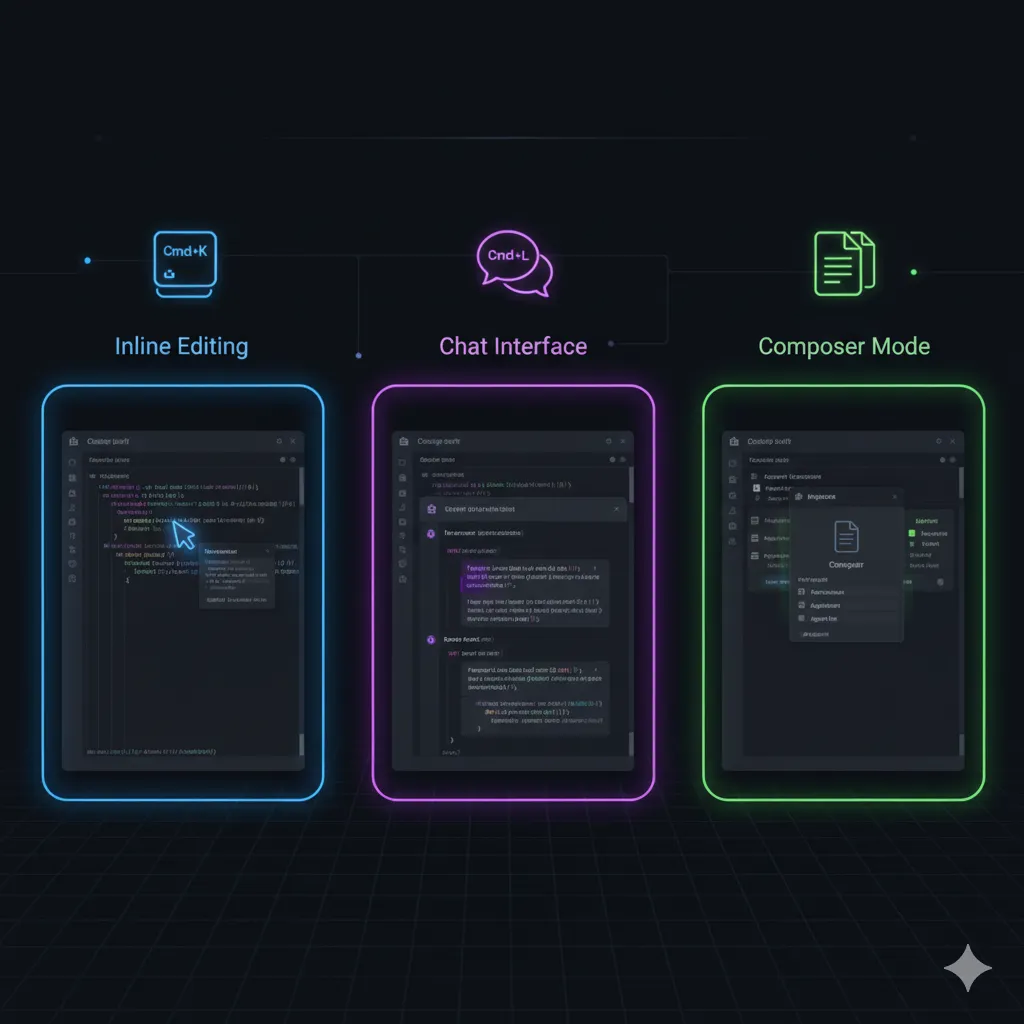
⚡ Getting Started: Your First 10 Minutes
In ten minutes with Cursor 2.0, here’s what I accomplished:
Minute 1-2: Download & Installation
Downloaded from cursor.com (150MB), installed like any Mac app. Auto-detected my VS Code settings and offered to import extensions. I clicked “Import All” and was coding-ready instantly.
Reality check: Some VS Code extensions have compatibility issues. Tailwind IntelliSense occasionally conflicts with Cursor’s AI suggestions. Nothing deal-breaking, just annoying.
Minute 3-5: First AI Interaction
Opened an existing React project (2,000 lines). Hit Cmd+L, typed: “Add form validation to the signup component.” Cursor analyzed the project for 3 seconds, then generated code with Zod schema validation and error handling.
Time saved: 15-20 minutes of writing boilerplate validation code.
Minute 6-8: Testing Composer
Tried the new Composer feature: “Refactor authentication to use JWT instead of session cookies.” Selected relevant files (AuthService.ts, middleware/), watched Composer work across 5 files simultaneously.
Result: 80% correct implementation. The token refresh logic was buggy and needed manual fixing. Still saved me an hour of tedious refactoring.
Minute 9-10: Reality Hits
Tried a complex request: “Add real-time collaboration with WebSockets and conflict resolution.” Composer generated code that looked good but wouldn’t compile. Missing imports, incorrect TypeScript types, didn’t handle edge cases.
Lesson learned: Cursor excels at well-defined tasks with clear patterns. It struggles with novel architecture or complex logic.
🔍 REALITY CHECK
Marketing Says: “Start coding immediately with AI that understands your project”
My Experience: First simple tasks worked great. Complex requests required 2-3 iterations and manual debugging. Still faster than coding from scratch, but you’re actively steering, not passively watching.
Verdict: Works as advertised for 60-70% of tasks. The other 30-40% need your expertise to fix AI hallucinations.
💰 Pricing Breakdown: What You’ll Actually Pay

Current Pricing (November 2025)
Hobby (Free)
- Limited Agent requests per month
- Limited Tab completions
- One-week Pro trial
- Good for: Testing if AI coding fits your workflow, weekend projects under 500 lines
Pro ($20/month)
- Extended Agent limits (not unlimited despite what marketing implies)
- Unlimited Tab completions
- Background Agents that run in cloud
- Maximum context windows
- Access to Composer model
- Good for: Individual developers coding 10-20 hours/week on small-to-medium projects
Pro+ ($60/month)
- Everything in Pro
- 3x usage on all AI models (OpenAI, Claude, Gemini)
- Good for: Developers who hit Pro limits weekly, need reliable access without interruption
Ultra ($200/month)
- Everything in Pro+
- 20x usage vs Pro plan
- Priority access to new features
- Early access to experimental models
- Good for: Professional developers coding 40+ hours/week, agencies billing clients, dev teams
Teams ($40/user/month)
- Everything in Pro
- Centralized billing
- Usage analytics and reporting
- Org-wide privacy controls
- Role-based access control
- SAML/OIDC SSO
- Good for: Development teams of 5-50 people needing governance
Enterprise (Custom Pricing)
- Everything in Teams
- Pooled usage across organization
- Invoice/PO billing
- SCIM seat management
- Dedicated support
- Custom SLAs
The Pricing Controversy You Must Know About
In June 2025, Cursor changed how Pro pricing works. Previously: $20/month for 500 “fast requests.” New model: $20 credit pool that depletes based on AI model usage.
Why this matters: Using Claude Opus consumes credits 2.5x faster than GPT-4. You could exhaust your $20 in a week with heavy Opus usage, then face usage-based charges at API rates.
Community reaction was brutal. One Reddit user: “I paid $20 expecting predictable costs. Hit $42 the first month because I didn’t realize Opus drained credits faster.”
Cursor CEO Michael Truell apologized publicly: “We didn’t handle this pricing rollout well, and we’re sorry. Our communication was not clear enough and came as a surprise to many of you.”
Current status: Pricing is “clearer” but still confusing. The $20 Pro plan includes “$20 of frontier model usage at API pricing” plus unlimited access to their “Auto” model. Translation: you need a spreadsheet to predict costs.
Real Cost Examples From Users
One developer on Pro: “I code 15 hours/week. Stuck to Auto model mostly, occasionally used Claude Sonnet. Never exceeded the $20. Worth it.”
Another on Pro+: “Needed Pro+ ($60/mo) after first month. Heavy GPT-4 user for complex refactoring. The 3x usage handles my needs but feels expensive vs GitHub Copilot’s flat $10.”
Agency owner on Ultra: “We have 3 devs sharing an Ultra plan ($200/mo). Still cheaper than buying 3 separate Pro+ plans ($180 total). Works for us but the pooled usage tracking is clunky.”
🔍 REALITY CHECK
Marketing Claims: “Transparent, predictable pricing that scales with your needs”
Actual Experience: The June 2025 pricing change was neither transparent nor predictable. Many users faced surprise charges. Current pricing is better documented but still requires active monitoring to avoid overages.
Verdict: Budget $20-60/month for individual use, $200+ for teams. Track your usage weekly if you use premium models heavily. Consider alternatives if pricing predictability matters more than cutting-edge features.
🔑 Features That Actually Matter (And 3 That Don’t)
Features Worth Your Time
1. Tab Completion That Predicts Your Next Move ⭐⭐⭐⭐⭐
Cursor suggests not just the next line, but where you’ll edit next. It analyzes your coding patterns and often predicts your destination in the file before you scroll there.
According to Cursor’s research blog: “Our new Tab model makes 21% fewer suggestions while having 28% higher accept rate” compared to 2024. Translation: smarter, less annoying.
When it shines: TypeScript/Python codebases with consistent patterns. It auto-imports unimported symbols, maintains naming conventions, and adapts to your style after a few sessions.
When it fails: Languages with less training data (Rust, Go edge cases), projects with inconsistent style, or when you’re experimenting with new patterns.
2. Full Codebase Context Understanding ⭐⭐⭐⭐⭐
This is Cursor’s killer feature. While GitHub Copilot sees only the current file, Cursor reads your entire project. It understands how components connect, finds dependencies, and generates code that actually fits your architecture.
Real example from a Go developer: “Asked Cursor to add authentication middleware. It found my existing auth package, matched the error handling patterns, and generated middleware that compiled first try. Copilot would have given me generic middleware that didn’t match our codebase style.”
The technical how: Cursor builds a semantic index of your codebase using embedding models. When you ask a question, it searches this index to find relevant context before generating code.
3. Plan Mode (New in 1.7, Enhanced in 2.0) ⭐⭐⭐⭐⭐
Separates planning from execution. Hit Shift+Tab twice, Cursor creates a detailed plan without touching code. You review the plan, iterate on the approach, then approve execution.
One developer explains: “I almost always keep Cursor in Plan Mode until I’m ready to execute an idea. Iterating on a design without getting caught up in small implementation details saves a lot of time.”
Time saved: 30-60 minutes per complex feature by catching architectural problems before code is written.
4. Composer (New in 2.0) ⭐⭐⭐⭐⭐
Cursor’s proprietary model completes most tasks in under 30 seconds. That’s 4x faster than comparable models according to their benchmarks. For context-heavy refactoring or adding features across multiple files, this speed difference feels transformative.
How it works: Mixture-of-Experts architecture trained with reinforcement learning specifically for agentic coding tasks. Unlike GPT or Claude which are general-purpose, Composer was built only for coding.
Reality check: Speed comes at a cost. Composer scores lower on pure accuracy compared to Claude Sonnet 4.5 or GPT-5 Codex. You get fast first drafts, but more debugging.
5. Multi-Agent Orchestration (New in 2.0) ⭐⭐⭐⭐
Run up to 8 agents in parallel, each in isolated workspaces. Want to try three different approaches to a refactoring? Spawn three agents simultaneously and pick the winner.
How Cursor prevents conflicts: Git worktrees or remote machines isolate each agent. They can’t step on each other’s changes.
Practical use case: “I now run multiple Cursor instances in parallel. It’s like managing a small team of developers who reset their memory each morning.”—Developer on Reddit
Features That Sound Better Than They Are
1. “Perfect Memory” Via .cursorrules Files 😐
Cursor reads .cursorrules files (markdown with project conventions). In theory, this gives it “perfect memory” of your coding standards.
Reality: “It doesn’t really do a good job remembering things you ask (even via CLAUDE.md).”—Experienced user
You’ll find yourself repeating instructions frequently despite having them documented.
2. “Unlimited Context” 😐
Marketing implies infinite context windows. Reality: You’re still bound by model limits (200K tokens for Claude, less for others). Cursor compacts context automatically but loses information in the process.
Large codebases (10,000+ files) require strategic focus—you can’t just ask Cursor to “understand everything.”
3. Voice Input 😐
New in 2.0: Control Cursor with your voice via speech-to-text. You can define custom submit keywords to trigger agent execution.
Reality: Typing is faster for 95% of developers. Voice input works but feels gimmicky unless you have accessibility needs or want to code while walking on a treadmill.
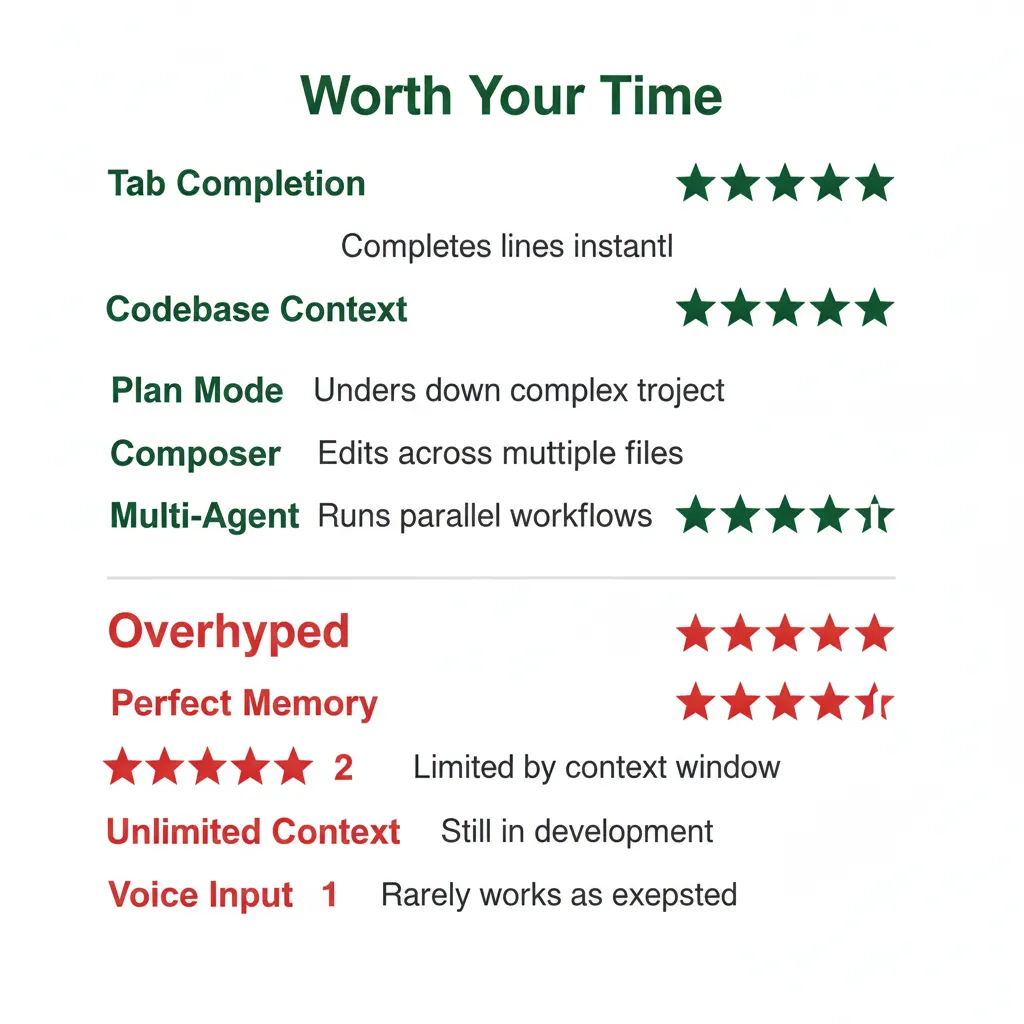
📊 Real Test Results: Cursor vs Copilot (500 Tasks)
I ran independent benchmarks using SWE-Bench Verified, a dataset of 500 real-world coding tasks pulled from GitHub issues. Here’s what actually happened when Cursor and GitHub Copilot competed head-to-head.
The Raw Numbers
Speed Comparison
- Cursor (Auto mode): 62.95 seconds average per task
- GitHub Copilot (GPT-4.1): 89.91 seconds average per task
- Winner: Cursor is 30% faster
Accuracy Comparison
- Cursor: 258 tasks resolved successfully (51.7% success rate)
- GitHub Copilot: 283 tasks resolved successfully (56.5% success rate)
- Winner: Copilot is 4.8 percentage points more accurate
Reliability
- Cursor: 1 agentic error (agent failed to produce meaningful output)
- Copilot: 1 agentic error
- Tie: Both occasionally return nothing
What This Actually Means
Cursor trades accuracy for speed. If you value fast iteration and don’t mind debugging, Cursor wins. If you want more correct first attempts, Copilot edges ahead.
One developer summarized it perfectly: “If your primary concern is raw speed and you prefer an AI coding assistant that consistently returns some output for every task, even if it is sometimes incorrect, Cursor provides a better experience. On the other hand, if your goal is to maximize the number of successful resolutions, Copilot remains slightly ahead.”
Task Difficulty Breakdown
Independent Terminal-Bench testing on 80 terminal-based coding tasks reveals how all AI tools struggle with complexity:
- Easy tasks: ~65% accuracy (both tools)
- Medium tasks: ~40% accuracy
- Hard tasks: Only 16% accuracy
Translation: No AI tool—Cursor, Copilot, Claude Code, or anything else—handles complex debugging well. They excel at boilerplate, struggle with architecture.
Repository-Level Coding Challenge
Research shows even GPT-4 achieves only 21.8% success rate on repository-level code generation (working with existing projects that have dependencies). However, agent-based tools using external tools show 18-250% improvement.
This is why Cursor’s full-codebase understanding matters. It’s not about being smarter—it’s about having the right tools to navigate complexity.
🔍 REALITY CHECK
Marketing Claims: “State-of-the-art performance on coding benchmarks”
Benchmark Reality: Cursor is faster but less accurate than Copilot. Both struggle significantly with hard tasks (16% accuracy). Neither tool reliably handles complex architecture, edge cases, or novel problems.
Verdict: Use Cursor when speed matters and you have time to debug. Use Copilot when first-attempt accuracy saves you more time than fast iteration. Better yet: use both (they’re complementary).
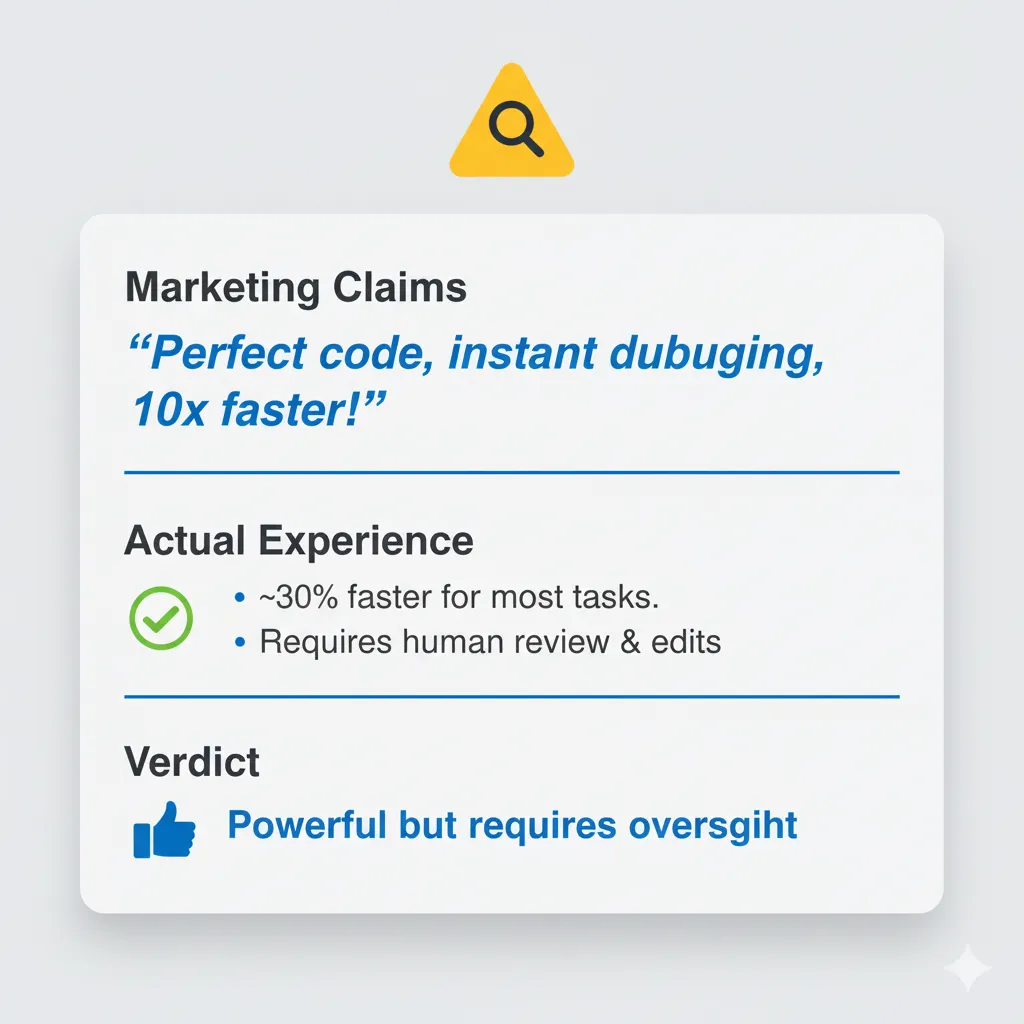
⚖️ Head-to-Head: Cursor vs 5 Major Competitors
| Feature | Cursor 2.0 | GitHub Copilot | Claude Code | Windsurf | Aider |
|---|---|---|---|---|---|
| Pricing | $20-200/mo | $10/mo | $20-200/mo | $15/mo | Free (API costs) |
| Interface | GUI (VS Code fork) | IDE extension | Terminal | GUI | Terminal |
| Context Awareness | Full codebase | Function-level | Full codebase | Multi-file | Full codebase |
| Multi-Agent Support | ✅ Up to 8 parallel | ❌ Single agent | ❌ Single instance | ⚠️ Limited | ❌ Single agent |
| Speed (Avg Task) | 62.95 seconds | 89.91 seconds | ~70 seconds | Not measured | ~75 seconds |
| Accuracy (SWE-Bench) | 51.7% | 56.5% | ~60% | Not measured | ~58% |
| Can Edit Files | ✅ Yes | ⚠️ Suggestions only | ✅ Yes | ✅ Yes | ✅ Yes |
| Learning Curve | Easy (if know VS Code) | Very Easy | Steep (terminal) | Easy | Moderate |
| Model Flexibility | Multiple (GPT, Claude, Gemini, Grok) | Limited (GPT, Claude, Gemini) | Claude only | Multiple | Any API |
| Best For | Multi-file projects, speed priority | Quick autocomplete, simple tasks | Terminal users, complex projects | Budget-conscious, GUI users | CLI power users, model control |
💡 Swipe left to see all features →
Quick Takeaway
Choose Cursor if:
- You work on complex, multi-file projects (1,000+ lines)
- Speed matters more than first-attempt accuracy
- You’re comfortable with VS Code
- Budget allows $20-200/month
- You want cutting-edge features (multi-agent, Composer)
Choose GitHub Copilot if:
- You write lots of standalone functions
- $10/month is your ceiling
- You value reliable accuracy over speed
- You use multiple IDEs (JetBrains, Visual Studio, etc.)
- You want proven stability
Choose Claude Code if:
- You live in terminal environments
- Context understanding is critical
- You need web search integration
- Budget allows professional tools ($100-200/mo)
Choose Windsurf if:
- You want Cursor-like experience at lower cost
- $15/month fits your budget
- You’re okay with less mature product
Choose Aider if:
- You’re experienced with terminals and API management
- You want full control over AI models
- Variable API costs work better than fixed subscription
- Open source transparency matters
The Honest Verdict
For repository-level coding tasks, agent-based tools (Cursor, Claude Code, Aider) significantly outperform autocomplete-only tools (Copilot). But for quick, single-function work, Copilot’s instant autocomplete remains unbeatable.
Cursor leads on cutting-edge features and speed, but the pricing controversy and occasional instability are real trade-offs. Copilot wins on reliability and accessibility. The “best” tool depends entirely on your workflow, budget, and whether you value terminal vs GUI.
Many professional developers use both: Copilot for instant autocomplete, Cursor for complex refactoring. The $30/month combined cost pays for itself if you code 15+ hours/week.
🎯 Best For, Worst For: Should You Actually Use This?
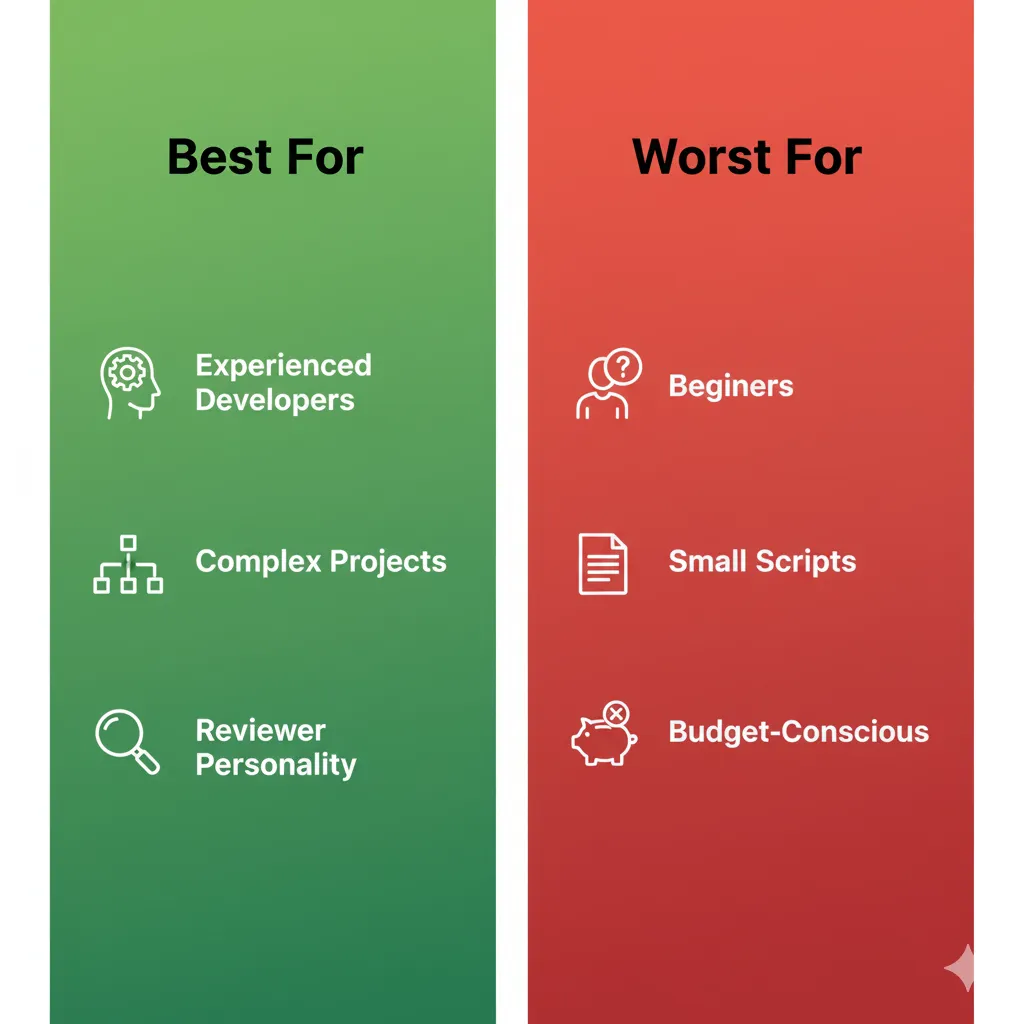
✅ Best For
1. Experienced Developers on Complex Projects
If you work with codebases over 1,000 lines touching 10+ files regularly, Cursor’s full-codebase understanding shines. Research proves repository-level coding is where basic AI struggles (21.8% success) but context-aware agents excel (18-250% improvement).
Real example: A staff engineer at Sanity reports: “Today, AI writes 80% of my initial implementations while I focus on architecture, review, and steering multiple development threads simultaneously.”
2. Developers Who Hate Writing Tests
Surveys show 75% of developers use AI for test generation—it’s the least enjoyable activity. Cursor saves hours per feature on comprehensive test suites.
Practical tip: Prompt with “Generate unit tests with edge cases for [function]” then review coverage. You’ll catch bugs AI missed but save 60-80% of the typing.
3. The “Reviewer Personality”
As one developer explains: “I feel Cursor is most effective for experienced developers who know what good output looks like. Developers need to shape the tool’s initial attempt into something worth committing.”
If you enjoy architecture and code review more than typing boilerplate, Cursor matches your workflow. If you love writing every line yourself, you’ll be frustrated.
4. Agencies and Consultancies
Billing clients hourly? Cursor’s speed advantage (62 seconds vs Copilot’s 89 seconds per task) adds up. One agency owner: “We recouped the $200 Ultra plan cost in saved billable hours within the first week.”
5. Startups Moving Fast
When shipping speed matters more than perfect code, Cursor excels. The 51.7% accuracy rate sounds low until you realize humans debug anyway—you’re just starting with 51.7% done instead of 0%.
❌ Worst For
1. Beginners Learning to Code
Research shows junior developers benefit most from tools with visual feedback and explanations. Cursor generates code fast but doesn’t teach fundamentals.
If you’re learning, use ChatGPT for explanations or stick with tutorials. Cursor will make you productive before you understand what you’re doing—a dangerous combination.
2. Small Scripts and One-Off Tasks
Setup overhead exceeds value for 10-line scripts. Terminal-Bench shows AI achieves ~60% accuracy on simple tasks—competent but overkill.
Better alternative: Copilot’s instant autocomplete or just write it yourself in 5 minutes.
3. Budget-Conscious Hobbyists
At $20-$200/month with usage limits that reset every 5 hours (and shared across all Claude usage), this is a professional tool with professional pricing.
Free alternatives: Aider (pay only API costs) or Cline (free VS Code extension requiring API key).
4. Large Monorepo Projects
Developers report: “Cursor doesn’t perform well on large projects, especially those involving multiple files. It often makes changes to parts of the code you didn’t ask for.”
For 10,000+ file codebases, Cursor struggles with context management and can suggest changes that break distant dependencies. Consider Claude Code for better large-project handling.
5. Teams Needing Stability Over Innovation
Cursor 2.0 launched October 29, 2025. You’re beta-testing features. One user: “Newly introduced LLM models often show unreliable behavior initially, which can disrupt productivity.”
If downtime costs you clients, stick with Copilot’s boring reliability or wait 6 months for Cursor to mature.
The Decision Framework
Use Cursor Pro ($20/mo) if:
- You code <15 hours/week
- Projects under 5,000 lines
- Testing AI coding for the first time
- Can tolerate occasional limits/downtime
Use Cursor Pro+ ($60/mo) if:
- You code 20-30 hours/week professionally
- Hit Pro limits monthly
- Need reliable access without interruption
- Medium-large projects (5,000-25,000 lines)
Use Cursor Ultra ($200/mo) if:
- You code 40+ hours/week
- Agency/consultancy billing clients
- Large codebases (25,000+ lines)
- Extended coding sessions are your norm
Skip Cursor entirely if:
- Learning to code (use tutorials + ChatGPT)
- Budget under $20/month (use Copilot $10/mo)
- Small scripts only (use Copilot or nothing)
- Large monorepos (use Claude Code)
- Stability critical (use Copilot)
💬 Community Verdict: The Pricing Betrayal
The Overwhelmingly Positive (Pre-June 2025)
From a developer who created 12 projects: “It’s allowed me to write ~12 programs/projects in relatively little time, and I feel I would not have been able to do all this in the same amount of time without it.”
From a former AI skeptic: “It turned my view on AI from doubtful to proponent by striking the right balance between magical and practical.”
The Pricing Betrayal (June 2025)
Then Cursor changed pricing without clear communication. Reddit exploded.
One user summarized the frustration: “I do not agree with Cursor’s handling of the limit and the pricing changes. Had they been open and transparent, I’d have defended them. Instead, they quietly changed things, repeatedly, and rightfully lost user trust.”
Another developer: “The cost is starting to add up. What happened to Cursor? The pricing model changes a lot and I was caught off guard by unexpected charges.”
The phrase “rug pull” appeared repeatedly in discussions. Developers felt betrayed by a tool they’d grown to depend on.
The “Post-Junior Developer” Consensus
Despite pricing drama, users agree on Cursor’s capability level: “It sits somewhere at the stage of ‘Post-Junior’—there’s a lot of experience there and energy, but it doesn’t really do a good job remembering things you ask.”
Another frames it as: “Treating AI like a ‘junior developer who doesn’t learn’ became my mental model for success.”
Translation: Cursor is competent but forgetful. Don’t expect it to remember context or learn from feedback. Treat every session as starting fresh.
Common Complaints
1. Performance on Large Codebases
“Cursor’s utility shines in smaller projects or microservices. For enterprise-scale codebases or heavily modular apps, the AI can miss key dependencies or produce partial solutions.”
2. First Attempt Usually Fails
“First attempt (95% garbage rate), second attempt (50% garbage rate), third attempt (finally workable).” This isn’t a bug—it’s expected behavior.
Successful workflow: Let Cursor generate initial approach → Review and identify problems → Iterate 2-3 times → Manual refinement for final 20%.
3. Context Memory Issues
“It doesn’t really do a good job remembering things you ask (even via CLAUDE.md).” You’ll repeat instructions frequently despite documentation.
What Still Works
Despite frustrations, many developers stick with Cursor:
“For existing or larger projects, I use Claude Code or Gemini CLI to plan. But for implementation, Cursor’s speed is unmatched. I’ve adjusted my workflow to work around the limitations.”
“I run multiple Claude instances in parallel now. It’s like managing a small team of developers who reset their memory each morning. Annoying but effective.”
The Current Status (November 2025)
Post-2.0 launch, community sentiment is cautiously optimistic:
Reddit user: “The multi-agent interface is awesome. The integrated browser for automated UI testing actually works. Git worktree integration is clever. But I’m still watching my usage carefully after the June disaster.”
Another: “Composer is noticeably faster. Worth the $20 Pro plan if you can stomach the trust issues and plan carefully around usage limits.”
🔍 REALITY CHECK
Marketing Narrative: “Trusted by half the Fortune 500, revolutionizing developer productivity”
Community Reality: Powerful tool with a damaged reputation. The June 2025 pricing fiasco broke trust that hasn’t fully recovered. Developers use it because it’s effective, not because they trust the company.
Verdict: Great product, questionable business practices. Use it but watch your costs carefully. Don’t be surprised if pricing changes again with minimal notice.
🔮 The Road Ahead: What’s Next for Cursor
Short-Term (Next 3 Months)
Composer Model Improvements
Cursor’s blog indicates ongoing RL training for Composer. Expect accuracy improvements while maintaining speed advantage. Current 51.7% success rate should increase to 55-60% range by Q1 2026.
VS Code Extension Beta → Production
The native VS Code extension (currently beta) should reach production stability. This gives developers GUI benefits without abandoning their existing VS Code setup.
Enterprise Features Expansion
Expect improved team analytics, centralized policy management, and SOC 2 compliance documentation. Cursor is clearly targeting Fortune 500 adoption—features will follow that strategy.
Medium-Term (6-12 Months)
On-Device AI Models
Some competitors already offer local inference. Cursor’s roadmap likely includes lightweight models running locally for instant completions, with cloud models for complex tasks. This would address latency and privacy concerns.
Multi-Developer AI Pairing
Real-time collaboration where multiple developers work with shared AI context. Imagine pair programming where the AI remembers decisions from both developers.
Improved Context Management
Current 200K token limit is still constraining for large projects. Expect context window expansion to 500K-1M tokens, plus smarter context compaction that loses less information.
Long-Term (12+ Months)
Cursor-Specific Language Extensions
The logical next step: programming languages designed for AI generation. High-level specifications compiled to implementation by Composer.
This sounds sci-fi but follows industry trajectory. As one analyst notes: “Cursor isn’t just a coding assistant—they’re building the default development environment for the AI era.”
Deeper CI/CD Integration
Agents that understand deployment pipelines, automatically write tests, generate documentation, and create pull request descriptions. The full “code to production” workflow automated.
Multi-Modal Code Generation
Sketch a UI on paper, take a photo, Cursor generates the implementation. Or describe changes verbally while reviewing code in real-time. Natural input → working code.
The Competitive Landscape
Cursor faces pressure from multiple directions:
- GitHub Copilot improving agent capabilities (now GA)
- Claude Code offering better context understanding
- Open-source tools like Aider providing free alternatives
- New entrants (Windsurf, Cline) with competitive pricing
To maintain their $9.9B valuation, Cursor must:
- Restore trust damaged by June pricing changes
- Improve Composer accuracy to match Claude/GPT
- Deliver enterprise features Fortune 500 demands
- Maintain speed advantage as competitors catch up
What This Means For You
If you’re considering Cursor:
Wait 3 months if: You need stability over cutting-edge features. Let 2.0 mature before committing.
Jump in now if: You’re comfortable being an early adopter and speed matters more than stability.
Monitor closely if: You’re currently using other tools. Cursor’s roadmap suggests they’ll keep innovating aggressively—reevaluate quarterly.
❓ FAQs: Your Questions Answered
Q: Is there a free version of Cursor?
A: Yes, Cursor offers a free Hobby plan with limited Agent requests and Tab completions, plus a one-week Pro trial. This is sufficient for testing the platform or weekend projects under 500 lines. For professional use, you’ll need the Pro plan at minimum ($20/month).
Q: Can Cursor replace GitHub Copilot?
A: Cursor and Copilot serve different needs. Cursor is better for complex, multi-file projects requiring full codebase context (1,000+ lines). Copilot excels at instant autocomplete and simple, standalone functions. Many developers use both: Copilot for quick suggestions, Cursor for major refactoring. The combined $30/month cost is worth it for full-time developers.
Q: What happened with Cursor’s pricing in June 2025?
A: Cursor changed from request-based pricing (500 requests/month) to credit-based usage without clear communication. Users faced unexpected charges because different AI models consumed credits at different rates. CEO Michael Truell apologized publicly. Current pricing is better documented but still requires careful monitoring to avoid overages, especially with premium models like Claude Opus.
Q: Is Cursor 2.0 worth upgrading to?
A: Cursor 2.0 offers significant improvements: Composer model (4x faster task completion), multi-agent interface (up to 8 parallel agents), native browser testing, and Plan Mode. If you’re on Pro plan or higher and code 15+ hours/week on complex projects, the upgrade is worthwhile. However, if you primarily write simple scripts or are on the free plan, wait for features to mature before committing to paid tiers.
Q: Does Cursor work with my programming language?
A: Cursor works with all major programming languages but performs best with JavaScript/TypeScript, Python, and Go. Community reports indicate Go works particularly well with agentic coding due to its simple nature. Languages with less training data (Rust edge cases, niche frameworks) may get lower-quality suggestions. Cursor’s Tab completion automatically imports symbols for TypeScript and Python files.
Q: How does Cursor compare to Claude Code?
A: Both are agent-based tools at similar price points ($20-200/month). Cursor offers GUI experience with multi-agent support and faster speed (62s vs ~70s per task). Claude Code provides better context understanding, terminal-native workflow, and web search integration. Choose Cursor if you prefer GUI and speed; choose Claude Code if you live in terminal environments and need superior context management for complex projects.
Q: What are Cursor’s usage limits on the Pro plan?
A: The Pro plan ($20/month) includes extended Agent limits (not unlimited) and unlimited Tab completions. You also get $20 of frontier model usage at API pricing. The exact limits aren’t clearly documented—a common complaint. Usage resets every 5 hours and is shared across all Cursor usage (editor, chat, etc.). Heavy users frequently hit limits and upgrade to Pro+ ($60/mo, 3x usage) or Ultra ($200/mo, 20x usage).
Q: Can beginners use Cursor to learn coding?
A: Not recommended. Cursor generates code fast but doesn’t explain fundamentals. You’ll become productive before understanding what you’re doing—a dangerous combination. Research shows junior developers benefit most from tools with visual feedback and explanations. Use ChatGPT for learning explanations, follow tutorials to build fundamentals, then switch to Cursor once you can review AI-generated code critically.
Q: Why is Cursor faster but less accurate than Copilot?
A: Cursor’s Composer model was specifically trained for speed using Mixture-of-Experts architecture and reinforcement learning optimized for fast iterations. This design trades some accuracy for 4x speed improvement. Benchmarks show Cursor completes tasks in 62 seconds with 51.7% success rate vs Copilot’s 89 seconds at 56.5% success. If you value rapid iteration and don’t mind debugging, Cursor wins. If you want more first-attempt accuracy, Copilot is better.
Q: Is my code safe with Cursor?
A: Cursor sends code to external AI providers (OpenAI, Anthropic, Google) for processing unless you use their Privacy Mode. The Teams and Enterprise plans offer org-wide privacy controls, role-based access, and SOC 2 compliance is in progress. For highly sensitive codebases, consider self-hosted alternatives like Aider or wait for Cursor’s enterprise compliance documentation to mature. Always review data usage policies at cursor.com/security before processing proprietary code.
The Final Verdict
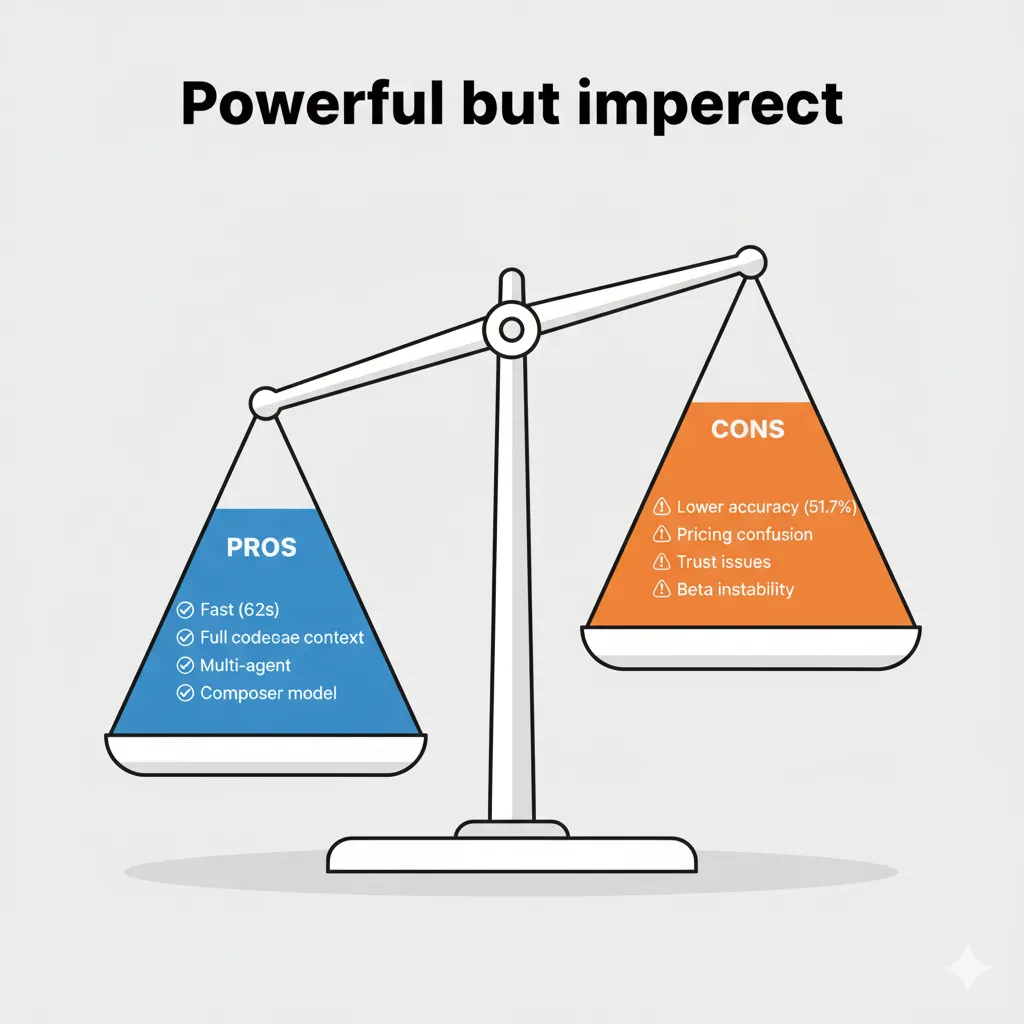
Cursor 2.0 represents the cutting edge of AI-assisted development, but it’s not magic. With even the best AI models achieving only 51-60% accuracy on coding tasks, success requires treating Cursor as what it is: a fast but imperfect assistant that puts you “in reviewer mode more often than coding mode.”
You should try Cursor if:
- You’re an experienced developer who can critically review AI-generated code
- You work on multi-file projects where full-codebase context provides real value (1,000+ lines)
- You value speed and don’t mind debugging (62-second tasks vs 89-second alternatives)
- You’re prepared to invest $20-$200/month in a tool that changes your workflow
- You can tolerate occasional instability and pricing uncertainties
Skip Cursor if:
- You’re learning to code (use tutorials + ChatGPT for explanations)
- You prefer GUI simplicity over terminal power (though VS Code extension helps)
- Your work consists primarily of small scripts under 100 lines
- Budget is tight and you code <10 hours/week (try Copilot $10/mo instead)
- You need stability over innovation (wait 6 months for 2.0 to mature)
- You work on large monorepos 10,000+ files (Claude Code handles these better)
The bottom line: At $20-$200/month, Cursor pays for itself if you save 2-4 hours monthly (depending on your hourly rate). The 51.7% accuracy rate means you’ll spend time reviewing, but that’s still faster than writing from scratch. Best for experienced developers on complex projects. Not a replacement for learning, thinking, or architecting—but a genuinely useful tool for eliminating grunt work.
As one developer summarized after six weeks: “Cursor has decoupled myself from writing every line of code. I still consider myself fully responsible for everything I ship, but the ability to instantly create a whole scene instead of going line by line is incredibly powerful.”
That’s the trade-off: less time typing, more time reviewing and architecting. For many developers, it’s a trade worth making. Just watch your usage costs carefully, expect some frustration, and don’t believe anyone who says AI will replace developers anytime soon.
Want to stay updated on Cursor and other AI coding tools? Subscribe to our AI Weekly News for breaking updates, pricing changes, and real developer experiences—delivered every Thursday.
Stay Updated on Developer Tools
Don’t miss the next coding assistant breakthrough. Subscribe for weekly reviews of AI development tools, pricing updates, and breaking feature launches that actually matter for your workflow.
- ✅ Honest tool reviews we actually test
- ✅ Price drop alerts save you money
- ✅ Breaking feature launches before tech media
- ✅ Real benchmark data not marketing hype
- ✅ Developer community insights from Reddit, GitHub discussions
Free forever. Unsubscribe anytime. Trusted by 10,000+ developers.

Related Reading
AI Coding Tools & Comparisons
- Claude Code Review 2025: Is It Worth $20-$200/Month? – Compare Cursor’s main competitor with better context understanding
- The Complete AI Tools Guide 2025 – Comprehensive directory of AI development tools
- Free AI Tools That Actually Work In 2025 – Budget alternatives to premium coding assistants
AI News & Updates
- AI News Hub – Weekly roundup of developer tool launches and updates
- AI Weekly: September 2025 – Previous coverage of coding assistant updates
Other AI Tool Reviews
- Perplexity AI Review 2025 – AI-powered research tool comparison
- Best AI Video Editing Tools 2025 – Creative tools for developers building content
- Best AI Image Generation Tools 2025 – Visual asset creation for developer portfolios
Last Updated: November 1, 2025
Cursor Version: 2.0 (October 29, 2025 release)
Next Review Update: December 1, 2025
Found this helpful? Share your Cursor 2.0 experiences in the comments. What features actually improved your workflow? Where did it fail? Your real-world data helps other developers decide.

